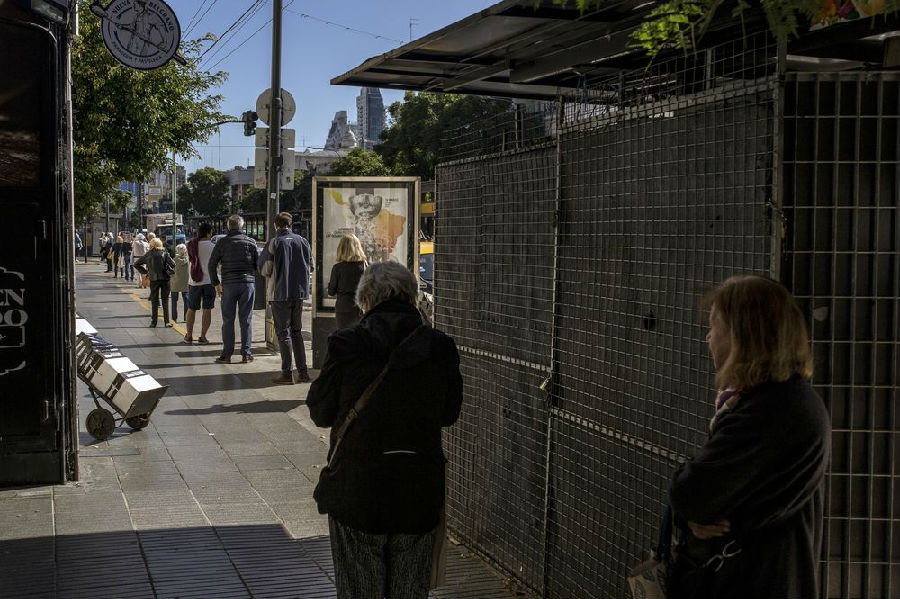Where covid-19 strikes, it reveals hard truths.
新型冠狀病毒肺炎所到之處,揭示了殘酷的事實。
In recent weeks Latin America has become the centre of the pandemic, responsible for over half of daily deaths.
在近幾周,拉丁美洲成為了疫情的中心,一半以上的每日死亡人數都來自這里。
The region's acute health crisis is accompanied by an economic decline unrivalled in the developing world.
該地區嚴重的健康危機還伴隨著一場發展中世界的其他國家所無法比擬的經濟衰退。
The IMF forecasts that output in the region will shrink by 9.4% in 2020,
國際貨幣基金組織(IMF)預測,2020年,該地區的產出將萎縮9.4%,
more than three times the contraction of 3% projected for emerging economies as a whole.
是整個新興經濟預測收縮的三倍多。
The economic and social devastation wreaked by the pandemic is all the more painful for coming on the heels of two underwhelming decades.
在未來普通的20年里,疫情所造成的經濟和社會災難更加痛苦。
Investors had waxed enthusiastic about Latin America's prospects
在2000年到2019年的新興市場繁榮時期,
during the great emerging-market boom of the 2000s and the 2010s, only to be disappointed.
投資者曾對拉丁美洲的前景充滿熱情,而現在只剩失望。
The few gains that were made seem almost certain to be reversed. The economies of Latin America are far from homogeneous.
取得的少數進展似乎肯定會逆轉。拉美國家的經濟體遠達不到同質化。
Many share characteristics, however, that have conspired to make the region among the hardest hit in the world.
然而,很多這些共同的特點使該地區成為全球受創最嚴重的地區之一。
In some places lockdowns have been stringent:
在一些地方,封鎖一直很嚴格:

Peru, for example, took the extraordinary step of closing its mines, the foundation of its economy,
例如,秘魯采取了不同尋常的措施,關閉了作為其經濟基礎的礦山,
contributing to the IMF's grim forecast of a decline in output of 14% this year.
導致IMF做出了其今年產出下降14%的悲觀預測。
But big and dense cities, with high rates of poverty and substantial segments of the population in informal work,
但人口密集的大城市,其高貧困率以及大量人口沒有正式工作,
have limited the effectiveness of lockdowns. The large informal sector, together with weak state capacity,
限制了封鎖的有效性。大型非正式部門,以及薄弱的國家能力
has also undermined the reach of government relief and exacerbated the economic collapse.
也削弱了政府救濟的范圍,加劇了經濟崩潰。
Populist blowhards with little time for experts govern the region's biggest economies, compounding its problems.
民粹主義信口開河的自吹自擂使該地區最大的幾個經濟體面臨的問題更加復雜。
The bleakness of 2020 in Latin America also owes much to the condition of its economies before the coronavirus spread.
2020年拉丁美洲的慘淡景象在很大程度上也要歸咎于其在冠狀病毒傳播之前的經濟狀況。
Many limped into the new decade.
很多國家掙扎著走進新的十年。
Growth across the continent—even excluding Venezuela, whose economy collapsed catastrophically in recent years—
整個大陸的經濟增長——甚至不包括近年來經濟災難性崩潰的委內瑞拉——
was just 1.8% in 2018 and 0.8% in 2019.
2018年僅為1.8%,2019年為0.8%。
By the start of this year, Argentina and Mexico were already in recession; many other countries were stagnating—including Brazil,
今年年初,阿根廷和墨西哥已經陷入衰退;很多其他國家經濟停滯——包括巴西
which enjoyed only the briefest of respites after a serious political and economic crisis in 2015 and 2016.
在2015年和2016年間一場嚴重的政治和經濟危機后,巴西經濟只得到了短暫的喘息。
These woes fit a longer-running pattern of Latin America falling behind.
這些困境符合拉美洲長期落后的模式。
The turn of the millennium marked the start of a great surge in the fortunes of the emerging world,
世紀之交標志著新興世界財富大幅增長的開始,
and a departure from the usual state of affairs, in which poorer countries only rarely caught up to rich-world incomes in sustained fashion.
這與通常情況不同,在通常情況下,較貧窮國家的收入很少能以持續的方式趕上富裕國家。
Trade grew explosively, commodity prices boomed and the developing world asserted itself more confidently on the world stage.
貿易呈爆炸性增長,商品價格大幅上漲,發展中世界在世界舞臺上更加自信。
In the 2000s real output per person across the emerging world (on a purchasing-power-parity basis) rose at an astonishing clip of 4.6% per year,
在本世紀頭10年,新興國家人均實際產出(以購買力平價為基礎)以每年4.6%的驚人速度增長,
or four times the pace achieved by rich economies.
這一速度是發達國家的四倍。
The great gaps in income between advanced countries and the rest that opened during the 20th century seemed destined to narrow and close in the 21st.
發達國家與20世紀開放的其它國家之間的巨大收入差距,似乎注定會在21世紀不斷縮小。
譯文由可可原創,僅供學習交流使用,未經許可請勿轉載。



